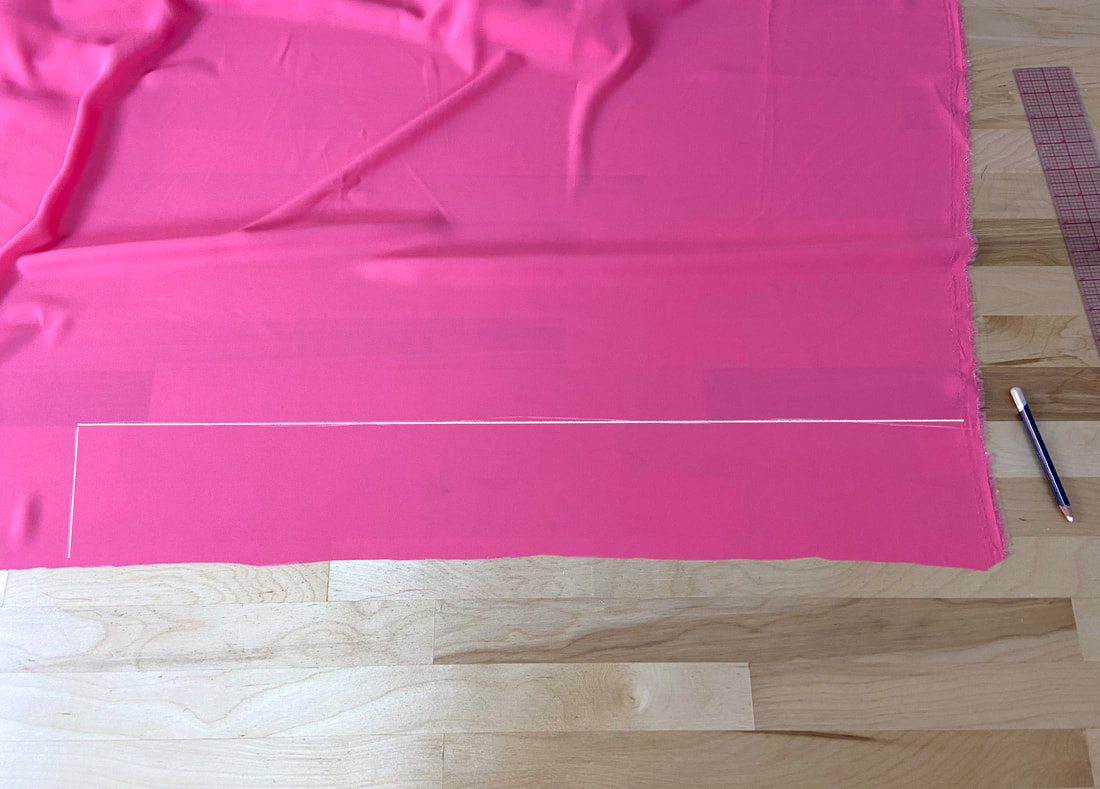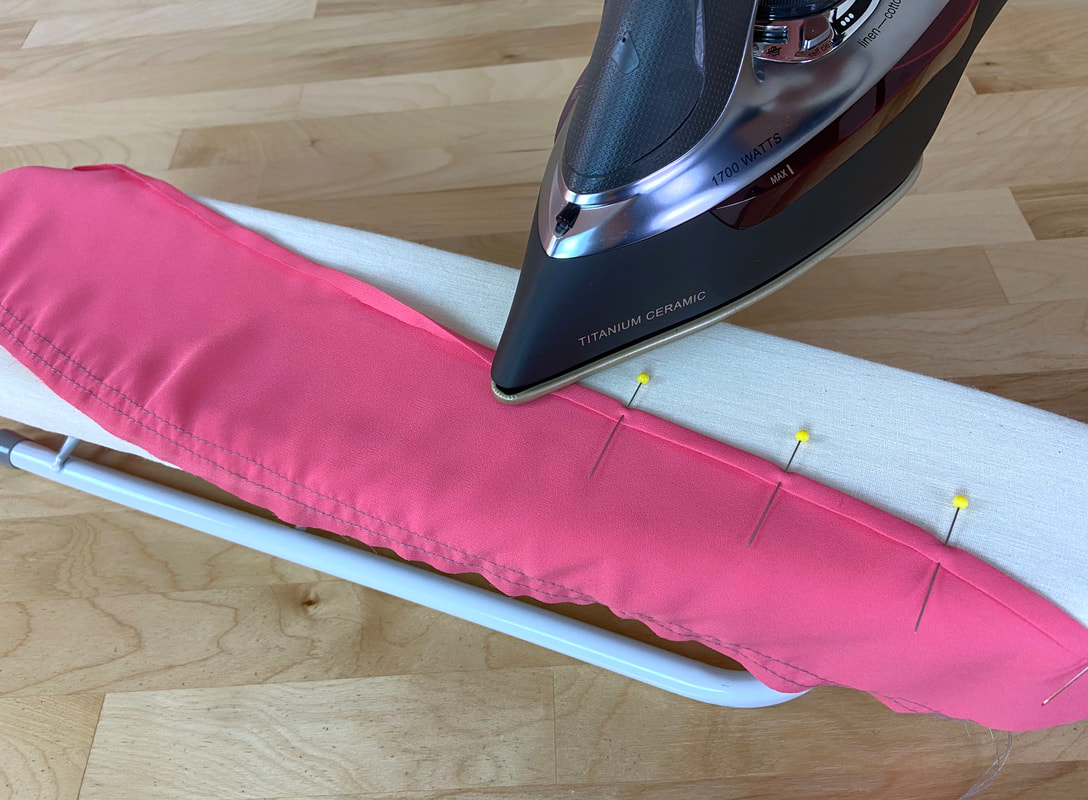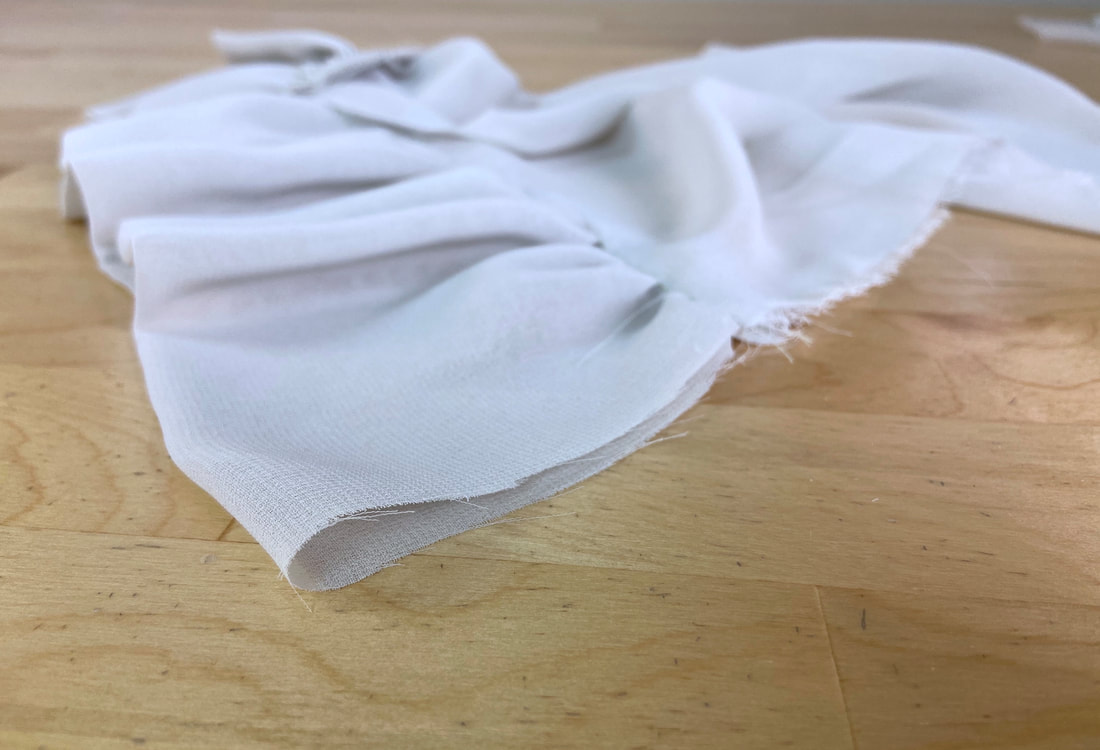Sewing a gathered ruffle into a seam is similar to sewing an actual gathered seam, but the ruffle is sewn as an inset as opposed to one of the seam edges. As you’ll see in the example below, sewing a ruffle into a seam is always easier than stitching it to the garment surface.
Marking And Cutting The Gathered Ruffle Fabric Strip
Let’s start by measuring and cutting the initial ruffle strip. Conventionally, this fabric strip is cut 2-3 times longer than the finished gathered ruffle.
Since the ruffle in this example will be sewn into the entire length of the seam, the fabric strip will be three (3) times longer than the length of the seam edge. The seam edge here is 10” inches thus the ruffle strip should be about 30” long.
Lay the fabric flat on the table and measure 30” along its crosswise grain as shown.
1. Lay the fabric flat on the table and measure 30” along its crosswise grain. Mark a straight line, 30” long, and add an extra 1” to account for ½” seam allowance on each end. Use tailor’s chalk, or a fabric pencil as shown.
Next, determine the final ruffle width. In this case, the ruffle will be 3” wide. To account for seam allowance, add 1” to this 3-inch measurement (1/2” seam allowance on each side).
2. Mark another parallel line at 4” distance from the first to complete the 31” x 4” rectangular strip. Carefully cut the marked fabric strip.
Sewing The Gathered Ruffle Into A Seam
1. Add a straight machine basting stitch next to the ruffle’s lengthwise seamline.
2. Add another basting straight stitch at about ¼” parallel to the first one, within the seam allowance as shown.
3. Clean-finish the opposite lengthwise edge with a double-folded topstitch or a rolled hem. In this example, the ruffle edge is folded twice (toward the wrong side of the ruffle) at ¼” distance each time, ironed and topstitched. This topstitched edge corresponds to the ruffle’s free-hanging edge.
Note: A simple way to finish the ruffle's free-hanging edge is to construct the entire ruffle in a double layer style. You can learn more about this technique is this tutorial: Sewing Double Layer Gathered Ruffles
4. Divide the garment’s seam edge into equal parts of 4” (or 6”). Insert pins or mark with a slash notch at each location.
5. Next, divide the ruffle’s stitched lengthwise edge into an equal amount of parts. Insert pins at each location. Each on of these portions should naturally be three (3) times longer than the ones on the garment’s seam edge- 12” in this case.
6. With the garment on its face side, align the stitched ruffle edge to the corresponding seam edge such that the ruffle’s wrong side is touching the face of the garment layer. Align each mark on the seam edge to each corresponding mark on the ruffle layer.
As noted above, the ruffle layer portions are three times longer and thus will hang down equally from pin to pin along the seam edge.
7. Once all corresponding points are matched and pinned together, pull the ruffle’s loose threads from the double stitch applied above and gather until the length of the ruffle matches that of the garment edge underneath. It helps to pull from both sides of the double stitch.
As you pull the stitch threads, distribute the gathering evenly using your fingers or a pin.
8. To better hold the ruffle and seam edges together, insert additional pins perpendicularly as shown.
9. With the ruffle side facing up, stitch on top of the bottom gathering stitching as shown. As you stitch, you may need to use your fingers or a pin to redistribute the gathers evenly in the process.
The final stitch should overlap the gathered basting stitch underneath.
10. Iron the gathered seam allowance using the tip of the iron. Don’t iron directly on the gathered ruffle as this will flatten it out causing it to lose its shape.
11. Align the corresponding seam edge to the ruffle seam with face sides touching and edges aligning. The ruffle should be sandwiched in between. Insert pins perpendicular to all edges to keep all seam layers together. Insert the pins from the side that shows the ruffle stitch applied in Step 9.
12. With the pins facing up, machine stitch the seam to the left of the existing ruffle stitch as shown. This ensures that all stitches are hidden within the seam allowance and not visible on the right side of the completed ruffle seam.
13. Trim the ruffle seam allowance as needed and apply an overedge stitch (like serging or zigzag) to clean-finish the fabric raw edges.
14. Iron the seamline carefully using the tip of the iron. Do not iron directly on top of the gathers.
In the final application, the seam allowance should point in the ruffle's opposite direction. The gathered ruffle is directed down and thus the seam allowance is naturally directed upwards.


























